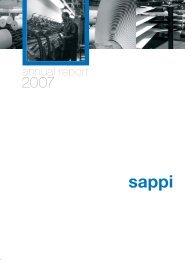2012 Integrated report - Sappi
2012 Integrated report - Sappi
2012 Integrated report - Sappi
Create successful ePaper yourself
Turn your PDF publications into a flip-book with our unique Google optimized e-Paper software.
Notes to the group annual financial statements<br />
for the year ended September <strong>2012</strong><br />
16. Trade and other receivables continued<br />
16.2 Analysis of amounts past due<br />
September <strong>2012</strong><br />
The following provides an analysis of the amounts that are past the due contractual maturity dates:<br />
Not impaired Impaired Total<br />
Less than 7 days overdue 13 – 13<br />
Between 7 and 30 days overdue 14 – 14<br />
Between 30 and 60 days overdue 1 – 1<br />
More than 60 days overdue – 10 10<br />
September 2011<br />
The following provides an analysis of the amounts that are past the due contractual maturity dates:<br />
28 10 38<br />
Not impaired Impaired Total<br />
Less than 7 days overdue 30 – 30<br />
Between 7 and 30 days overdue 12 – 12<br />
Between 30 and 60 days overdue 4 – 4<br />
More than 60 days overdue 2 15 17<br />
48 15 63<br />
All amounts due which are beyond their contractual repayment terms are <strong>report</strong>ed to divisional management on a regular basis.<br />
Any provision for impairment is required to be approved in line with the group limits of authority framework.<br />
The group holds no collateral (2011: no collateral) against overdue trade receivables.<br />
The group has granted facilities to customers to buy on credit for the following amounts:<br />
<strong>2012</strong> 2011<br />
Less than US$0.5 million 289 299<br />
Less than US$1 million but equal to or greater than US$0.5 million 258 277<br />
Less than US$3 million but equal to or greater than US$1 million 524 597<br />
Less than US$5 million but equal to or greater than US$3 million 219 213<br />
Equal to or greater than US$5 million 939 1,031<br />
2,229 2,417<br />
16.3 Trade receivables securitisation<br />
The group operates two trade receivables securitisation programmes due to the cost effectiveness of such structures.<br />
The <strong>Sappi</strong> Southern African securitisation programme is off-balance sheet and is described in detail in note 16.4.<br />
In fiscal 2011, the group replaced its existing on-balance sheet securitisation programmes with a single three-year committed trade<br />
receivables purchase programme with UniCredit Bank AG with a programme limit of €360 million. Trade receivables sold in terms of<br />
this programme are disclosed on the balance sheet together with a corresponding liability.<br />
At fiscal year-end, trade receivables with a value of US$490 million (2011: US$491 million) have been pledged as collateral for amounts<br />
received as funding under the programme of US$377 million (2011: US$368 million). The group is restricted from selling or repledging<br />
the trade receivables that have been pledged as collateral for this liability. For more detail on this programme, refer to note 20.<br />
16.4 Off-balance sheet structures<br />
Letters of credit discounting<br />
To improve the group’s working capital, the group sells certain Letters of Credit to Royal Bank of Scotland (‘RBS’), Hong Kong and Union<br />
Bancaire Privee (‘UBP’), Switzerland at each fiscal month-end on a non-recourse basis.<br />
Scheckwechsel<br />
The Scheckwechsel is a financial guarantee supplied by <strong>Sappi</strong> to the bank of certain customers (trade receivables) who wish to obtain a<br />
loan to finance early payment of specified trade receivables (thereby benefiting from an early settlement discount). By signing the<br />
Scheckwechsel, <strong>Sappi</strong> provides a financial guarantee to the bank of the customer.<br />
This financial guarantee contract is initially recognised at fair value. The fair value at inception is zero as the risk of <strong>Sappi</strong> having to<br />
reimburse the bank is nil (there is no evidence that the customer will not reimburse its loan to the bank), there is no guarantee fee payable<br />
by the bank and the Scheckwechsel is a short-term instrument (maximum 90 days). Subsequently, the financial guarantee contract is<br />
measured at the higher of:<br />
(i) the amount determined in accordance with IAS 37 Provisions, Contingent Liabilities and Contingent Assets; and<br />
(ii) the amount initially recognised less any cumulative amortisation.<br />
As no event of default has occurred, no provision has been set up and the fair value at year-end remains at zero. However, according to<br />
IAS 37, a contingent liability of US$29 million (2011: US$32 million) has been disclosed in this respect.<br />
130
















